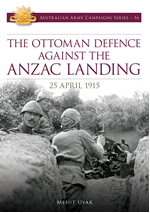The Ottoman Defence against the Anzac Landing: 25 April 1915 places us one step closer towards better understanding the events of this fateful day. The landing at Gallipoli on 25 April 1915 represents a significant moment, not only for Australia and New Zealand, but also for Turkey. Yet, despite a plethora of accounts of the landing from the allied perspective, a detailed account from the Turkish perspective had not been published in English until now.
The Ottoman Defence begins to address this imbalance in recording and understanding historical events. The challenge to clarify the fog and confusion of war has led the author to focus exclusively on that key first day of what would become an 8-month-long battle.
To provide context for that one day, in the first half of the book he describes and analyses the Ottoman forces to gain a better appreciation for them as an actor in these events, as well as their preparations for their defence of the Dardanelles. And, unsurprisingly, they were not as weak as the Allies assessed ahead of the campaign.
Mesut Uyar is a former Turkish military officer and now an associate professor of Ottoman military history at the University of New South Wales, Canberra. A specialist in war studies and military history, he has the advantage of being able to read original Ottoman documents and has published articles on the Ottoman military.
Using Ottoman military documents, regimental war diaries, personal accounts and memoirs, Uyar describes the unfolding campaign, unravelling its complexity and resolving many of the questions that have dogged allied accounts for a century.
Significantly, Uyar resolves the enduring controversy about the presence of Ottoman machine guns. Heconfirms that while machine gun positions had been prepared on Ariburnu, on 400 Plateau, and near the Fisherman’s Hut, the initial pre-dawn landing was not opposed by machine guns, which had been kept in reserve. The first four machine guns arrived at Scrubby Knoll on Third Ridge around 0740 hours, and four more arrived at Chunuk Bair around 1000 hours. Four more arrived around 1530 hours.
The author periodically notes which Anzac forces he believes were opposite the Ottomans as the day’s events unfold. He has done this in conjunction with Chris Roberts who wrote the authoritative The Landing at Anzac 1915. Indeed, there is merit in reading these two accounts in parallel. There remains a task, however, to comprehensively merge and rationalise the different accounts to achieve a more complete and balanced understanding of events. Such a task is further complicated by different names being used by each side for the same geographic features. As ever, however, a fully complete retrospective understanding of significant historical events is impossible.
The Ottoman Defence includes a large number of colour and black-and-white photos and images – many from private collections and published for the first time. Throughout, the author has usefully included ‘side boxes’ to provide additional background on key personalities, organisations and equipment. There are many colour maps that enable the reader to easily relate the described events to the ground, as well as several colour plates of Ottoman field maps marked on the day. As an academic work, the book includes notes on the Turkish sources, a selected bibliography and a comprehensive index.
The Ottoman Defence enhances our understanding of the Ottoman military forces of the time and why they proved so successful in containing and ultimately defeating the Allied invasion. It helps to provide a more balanced and complete understanding of the chaotic events of that day and as such is both interesting and valuable to students of military history. The relatively low price means that there are few excuses for not including such an excellent production in your library.

Contact Marcus Fielding about this article.






